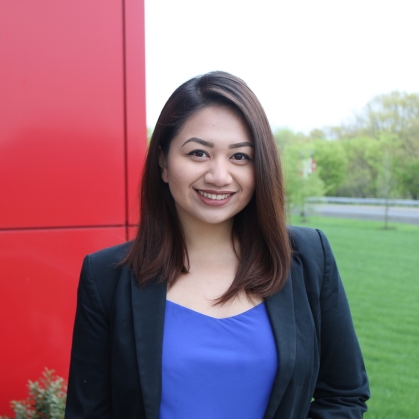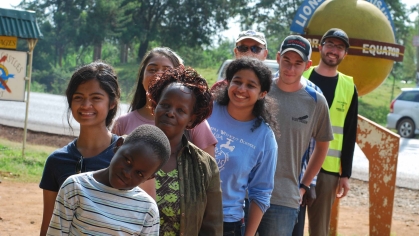Meet Arielle Gamboa
Arielle Gamboa joins professor's research team and contributes to published material

When Arielle Gamboa began her studies at Rutgers in 2015, she took an introductory engineering class taught by Jonathan Singer, who often shared his enthusiasm for nanotechnology with the students. These included approaches to manufacture electronic circuits and biological devices with features measuring little more than a handful of atoms in size.
What Gamboa didn’t expect at the time was that she’d soon have the opportunity to work alongside the assistant professor of mechanical and aerospace engineering, who like her was also in his first year at Rutgers.
As the daughter of two engineers and younger sister of two more, Gamboa knew she wanted to study engineering. But she wasn’t aware of the opportunities she’d have to pursue research in a university.
“I’ll admit when I first took his class, I didn’t see myself doing research with him, because I didn’t even think about doing research at the time,” she said. But that changed in the spring, when Gamboa learned of the university’s Aresty Research Center.
The center’s summer science program matches rising sophomores interested in exploring research with faculty mentors willing to show them the ropes. Singer is one of the professors in the program, and Gamboa thought it might be a great experience.
Her two month summer stint stretched into a three-year collaboration that included her being first author on a paper published in one of the Materials Research Society’s journals, MRS Advances.
Singer acknowledges that being a new professor when Gamboa started working with him provided her and her undergraduate peers with opportunities that later undergraduates in his lab might not share.
“I only had one graduate student in my first year, so that first group of undergraduates had a lot of responsibility,” he said. “They were asked to take on a graduate student level of participation a little earlier. They got a lot more one-on-one interaction with me trying to push these projects forward.”
Gamboa plunged right in, first working on patterning metal and polymer films for applications such as flexible electronics, implantable medical devices and electrodes for propulsion systems in CubeSats – small satellites that make experiments in space more affordable.
He’s been a great mentor,” she says of Singer. “He’s always guiding us, he asks for our input. We’re not just being told what to do; it’s a two-way conversation.”
Gamboa focused on a process called “dewetting,” a phenomenon where a liquid film will break into regions with material and regions without it. She went beyond the rather straightforward process of dewetting a single film layer to sequentially dewetting two layers of material, such as a polymer on top of metal. The result is finely patterned microscale features in both layers that align perfectly with each other - a technique that shows promise for manufacturing affordable flexible electronics.
The process of preparing a journal article challenges students to write for an audience of experts, something that’s rarely expected of undergraduates, explained Singer. And feedback from peer reviewers transcends letter grades that students get on class papers.
“Very rarely will students get feedback such as, ‘did you consider this,’ or ‘you didn’t consider this,’ or ‘what are you going to do about that?’” he said. “The best sorts of reviews make you think about your work and make it better.”
While Gamboa’s paper will be an asset on her resume, Singer says it’s not the be-all and end-all of her research experience.
“What’s significant is that the student had the dedication to get a project to the point where it was time to report it,” he said. “It meant that the student was willing to put in that depth of effort.” He has mentored other undergraduates who put in the same effort, but couldn’t publish because the technology is being patented or the research process doesn’t always deliver immediate results.
Gamboa is originally from the Philippines, and later spent 12 years in Dubai, United Arab Emirates, where she attended an international preparatory school. She met a Rutgers representative at her school who impressed her with the university’s location, size and quality of the engineering school. Gamboa continued her education at Rutgers and graduated with a combined BS/MS degree in spring 2020 after completing her thesis, titled Morphological Control of Multifunctional Melting Gel Coatings via Electrospray Deposition, advised by Singer. She will pursue a doctoral degree at University of Illinois at Urbana/Champaign in mechanical engineering.


